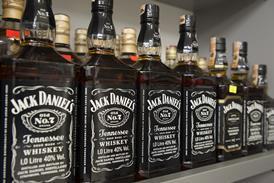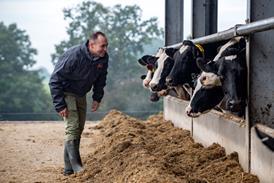The Red Meat Industry Forum claims it has started to deliver. Ed Bedington reports
More than a year ago, meat bosses unveiled an ambitious plan to try and turn around the fortunes of the ailing red meat sector.
Today, attitudes from the industry towards the Red Meat Industry Forum are beginning to change and initial cynicism giving way to an almost evangelical belief, according to chairman Peter Barr, who will be speaking at the second RMIF conference in London next week.
A number of the initial projects are now well under way, he says, and the time is right to start revealing some of their findings to the rest of the industry.
“Eighteen months on, we feel we have enough information from our pilot work to share with the sector,” he says.
“The difference this time is that instead of us talking about theories, we’ll have the people involved in the work, some of whom are almost evangelical about what we’ve been doing.”
The concept of the forum, forged in the fires of foot and mouth, was to focus on business practices, from management issues to supply chain efficiencies.
“I estimated we were 25% out on price, compared with our EU competitors,” says Barr. The price difference could be broken down into three parts, he says: 10% of it was down to currency adjustments, a situation since rectified; a further 10% needed to be clawed back with improvements in efficiency; and the remaining five would be gained through greater product differentiation, adding value and innovating.
“The work of the forum isn’t just about taking out cost, it’s also about adding value.”
The inaugural conference set out two main objectives. One was to get the red meat industry back on its feet by boosting both its image and consumption levels, while the longer term initiative was to improve the industry’s competitiveness.
Barr says: “We set a target of June 2004 for the first part and managed to achieve that 18 months ahead of schedule. Consumption of red meat is now at its highest since 1990.The image of meat is the best it has been for a decade and vegetarianism is in retreat.”
The work of the forum began in earnest with the creation of 10 pilot projects, with grant funding from DTI and DEFRA among others, all revolving around benchmarking and improving the supply chain.
Martin Grantley-Smith, director with the RMIF, says the net was cast wide in the search for solutions, with help and valuable business techniques gained from major companies such as Procter & Gamble and even some lessons from the car industry.
The forum has seen a remarkable change in fortunes, says Barr, who describes the initial attitude towards it as one of scepticism. They almost had to twist arms to get people to take part, he admits. “But those who did get involved have become strong advocates of our work. The last thing the industry needed was another talking shop or committee, but the people who have got involved really see the value of it.”
The point of this week’s conference is to start getting the word out to the meat industry, to get it moving in the direction the forum is pointing it in.
In the meantime, Barr and his team will continue to push on with the 10 projects, generating further invaluable data that could help create a brighter future for the red meat industry.
“We’re in a world that’s changing at such high speed, competition is only going to get tougher, and changes to the Common Agricultural Policy and at the WTO aren’t going to make things any easier,” says Barr. “We need to convince the industry to work together, to recognise that its competitor isn’t its neighbour down the road.
“The competition is going to come from South America as well as from an enlarged European Union.”
He said the business methods and practices that the RMIF is highlighting are not just one-offs. The industry needs to be constantly analysing itself and benchmarking. “The concept of continuous improvement needs to be absorbed into the supply chain.”
Above all, however, he’s not afraid to set out the RMIF’s ambitions. “We would like to have improved the competitiveness of the industry by 5% before the end of 2006.
“That’s a serious target to set up and be measured against, but we’re not afraid to be judged on that.”
More than a year ago, meat bosses unveiled an ambitious plan to try and turn around the fortunes of the ailing red meat sector.
Today, attitudes from the industry towards the Red Meat Industry Forum are beginning to change and initial cynicism giving way to an almost evangelical belief, according to chairman Peter Barr, who will be speaking at the second RMIF conference in London next week.
A number of the initial projects are now well under way, he says, and the time is right to start revealing some of their findings to the rest of the industry.
“Eighteen months on, we feel we have enough information from our pilot work to share with the sector,” he says.
“The difference this time is that instead of us talking about theories, we’ll have the people involved in the work, some of whom are almost evangelical about what we’ve been doing.”
The concept of the forum, forged in the fires of foot and mouth, was to focus on business practices, from management issues to supply chain efficiencies.
“I estimated we were 25% out on price, compared with our EU competitors,” says Barr. The price difference could be broken down into three parts, he says: 10% of it was down to currency adjustments, a situation since rectified; a further 10% needed to be clawed back with improvements in efficiency; and the remaining five would be gained through greater product differentiation, adding value and innovating.
“The work of the forum isn’t just about taking out cost, it’s also about adding value.”
The inaugural conference set out two main objectives. One was to get the red meat industry back on its feet by boosting both its image and consumption levels, while the longer term initiative was to improve the industry’s competitiveness.
Barr says: “We set a target of June 2004 for the first part and managed to achieve that 18 months ahead of schedule. Consumption of red meat is now at its highest since 1990.The image of meat is the best it has been for a decade and vegetarianism is in retreat.”
The work of the forum began in earnest with the creation of 10 pilot projects, with grant funding from DTI and DEFRA among others, all revolving around benchmarking and improving the supply chain.
Martin Grantley-Smith, director with the RMIF, says the net was cast wide in the search for solutions, with help and valuable business techniques gained from major companies such as Procter & Gamble and even some lessons from the car industry.
The forum has seen a remarkable change in fortunes, says Barr, who describes the initial attitude towards it as one of scepticism. They almost had to twist arms to get people to take part, he admits. “But those who did get involved have become strong advocates of our work. The last thing the industry needed was another talking shop or committee, but the people who have got involved really see the value of it.”
The point of this week’s conference is to start getting the word out to the meat industry, to get it moving in the direction the forum is pointing it in.
In the meantime, Barr and his team will continue to push on with the 10 projects, generating further invaluable data that could help create a brighter future for the red meat industry.
“We’re in a world that’s changing at such high speed, competition is only going to get tougher, and changes to the Common Agricultural Policy and at the WTO aren’t going to make things any easier,” says Barr. “We need to convince the industry to work together, to recognise that its competitor isn’t its neighbour down the road.
“The competition is going to come from South America as well as from an enlarged European Union.”
He said the business methods and practices that the RMIF is highlighting are not just one-offs. The industry needs to be constantly analysing itself and benchmarking. “The concept of continuous improvement needs to be absorbed into the supply chain.”
Above all, however, he’s not afraid to set out the RMIF’s ambitions. “We would like to have improved the competitiveness of the industry by 5% before the end of 2006.
“That’s a serious target to set up and be measured against, but we’re not afraid to be judged on that.”















No comments yet